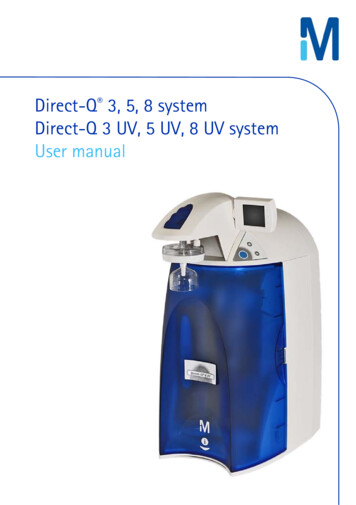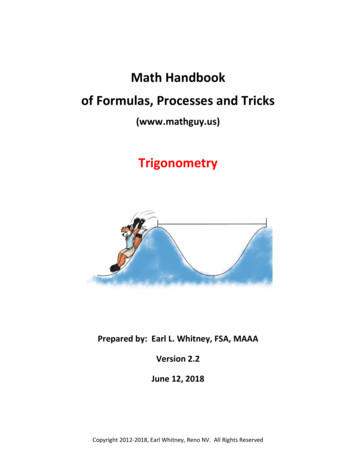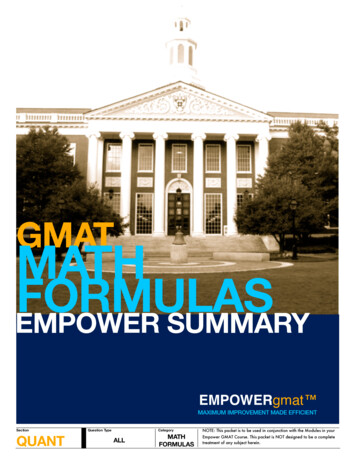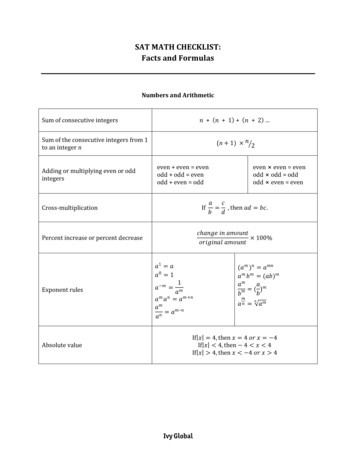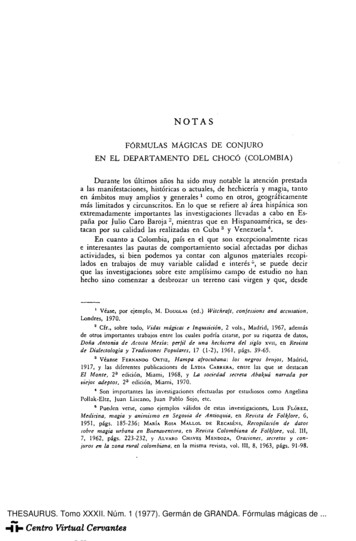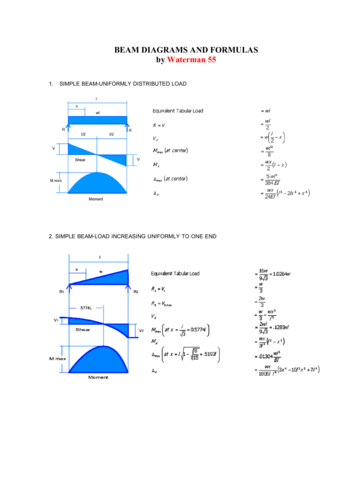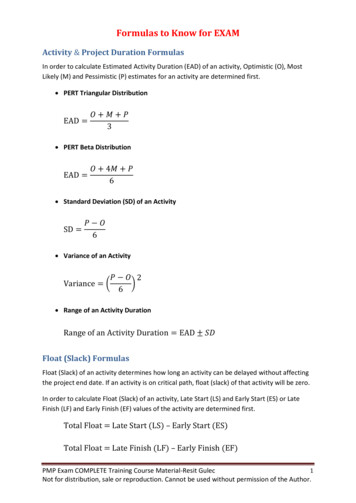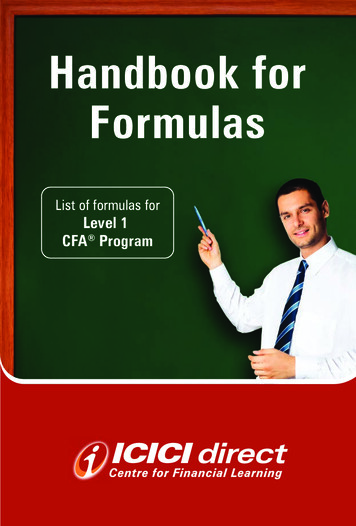
Transcription
Handbook forFormulasList of formulas forLevel 1CFA Program
TIME VALUE OF MONEY1Nominal interest rate real risk-free rate expected inflation rate2Required interest rate on security nominal risk-free rate default risk premium liquiditypremium maturity risk premium3Effective Annual Return (EAR) EAR (1 periodic rate)m -1Periodic rate stated annual rate/mM number of compounding periods per year4FV PV(1 I/Y)NFVPV N1 IYFV future valuePV Present valueI/Y Rate of return per compounding periodN Number of compounding periods5PV perpetuity PMT(I/Y)PMT Fixed periodic cash flow6CF139 (1 r)tDISCOUNTED CASH FLOW APPLICATIONCF Expected cash flowr Discount rateIRR70 CF CF1CF2CF3 (1 IRR)(1 IRR)2(1 IRR)3IRR Internal rate of return.8HPR (Ending Value-Beginning Value)(Beginning Value)HPR Holding period return9RBD D/F*360/tRBD Annualised yield on a bank discount basisD Dollar discount purchase price - face valueF Face valuet Number of days until maturity360 Bank convention of number of days in a year10Effective Annual Yield (EAY) (1 HPY)365/t -1HPY Holding period yieldCentre for Financial Learning
11RMM 360/days*HPYRMM Money market yield12Bond equivalent yield {(1 effective annual yield)1/2-1} * 213Geometric Mean [(1 R1)(1 R2) . (1 Rn)]1/n-1Geometric mean return is also known as compound annual rate of return14Harmonic Mean 15Position of observation at a given percentileyLy (n 1)10016Range Maximum Value- Minimum Value17Mean Absolute Deviation (MAD) ; ULWKPHWLF PHDQ18Population Variance( (Xi-μ)2)σ2 N19Standard Deviationσ square root of variance20Sample VarianceN [ ;L ;n( (Xi-μ)2)N-1Chebyshev’s InequalityPercentage of observations that lie within k standard deviations of the mean is at least 1-1/k2σ2 212223Coefficient of Variation(standard deviation of x)CV (average value of x)(Rp-RFR)σpRp Portfolio ReturnRFR Risk Free Rateσp standard deviation of portfolio returnSharpe Ratio 24 ;L [ 3)Sample Skewness (Sk) S3s sample standard deviation25Sample Skewness (Sk) 26Excess Kurtosis Sample Kurtosis - 3 ;L [ 4)S4Centre for Financial Learning
PROBABILITY CONCEPTS27Multiplication Rule Of Probability,P(AB) P(A/B)*P(B)28Addition Rule Of Probability,P(A or B) P(A) P(B)-P(AB)29Total Probability Rule (Used to determine unconditional probability of an event)P(A) P(A/B1)P(B1) P(A/B2)P(B2) P(A/BN)P(BN)30Expected value of random variable weighted average of possible outcomes,Weights probabilities that the outcome will occur31CovarianceCov(Ri, Rj) E{[Ri-E(Ri)][(Rj-E(Rj)]}Cov(Ri, Rj) Corr(Ri, Rj) σ(Ri)σ(Rj)32Correlation Cofficient(Cov(Ri,Rj))Corr(Ri,Rj) (σ(Ri)σ(Rj))33Weight of asset in portfolio,w market value of investment in asset i/market value of the portfolio34Portfolio Expected ValueE(Rp) w1E(R1) w2E(R2) wnE(Rn)35Variance of 2 Asset Portfolio36Variance of 3 asset Portfolio37Bayes Formula,Updated Probability ( Probability of new information for a given event / unconditionalprobability of new event )*(prior probability of event)38Factorialn! n*(n-1)*(n-2)*(n-3) *10! 139Labelling,n! / (n1!)*(n2!)* . ( nn!)40Combination,n Cr n! /(n-r)!r!Permutation,n! /(n-r)!41COMMON PROBABILITY DISTRIBUTIONS42To standardize a normal variable,z (Observation - Population Mean)(Standard Deviation)Centre for Financial Learning
43Roy’s safety first criteria,([E(Rp)-Rl])SFR (σ p)**Choose the portfolio with largest SFR44Continuously compounded rate of return,Rcc ln(1 HPR)45Standard Error of sample Mean,σx σ Qσ Standard deviation of populationn Size of the sample46t-distribution to construct a confidence interval,When variance is unknown,x tα/2 V QSAMPLING AND ESTIMATIONWhen variance is known,x tα/2*σ Qx Point estimate of population meantα/2 The t-reliability factorV Q 6WDQGDUG HUURU RI VDPSOH PHDQSAMPLING AND ESTIMATION47(Sample Mean - Hypothesized Mean)Test Statistic (Standard Error of Sample Mean)48t-statisticWhen population variance is unknown,(x-μ)Tn-1 (s/ n)When population variance is known,(x-μ)Tn-1 4950(σ/ n)Chi-square test: X2 (n-1)s2σ2F-distribution test,F s12/s22TECHNICAL ANALYSIS51Arms Index or Short Term Trading Index,(Number of advancing Issues / Number of declining issues)TRIN (Volume of advancing issues / Volume of declining issues)Centre for Financial Learning
DEMAND AND SUPPLY ANALYSIS: INTRODUCTION52'HPDQG IXQFWLRQ IRU JRRG ; Qdx f(Px,I,Py, .)3[ 3ULFH RI JRRG ; , 6RPH PHDVXUH RI DYHUDJH LQFRPH SHU \HDU Py Prices of related goods533ULFH (ODVWLFLW\ RI 'HPDQG 4XDQWLW\ 'HPDQGHG 3ULFH FKDQJH54&URVV 3ULFH (ODVWLFLW\ 4XDQWLW\ 'HPDQGHG 3ULFH 2I 5HODWHG *RRGV FKDQJH55,QFRPH (ODVWLFLW\ 4XDQWLW\ 'HPDQGHG LQ ,QFRPH FKDQJH56Accounting profit total revenue-total accounting costs57Economic profit accounting profit-implicit opportunity costsOrEconomic profit total revenue-total economic costs58Normal profit,Economic profit accounting profit-normal profit 0Normal profit is the accounting profit that makes economic profit equal to zero59Marginal Cost,MC change in total cost/change in output601RPLQDO *'3 3L W4L WPi,t Price of good i in year t. Qi,t Quantity of good I produced in year t61GDP deflator (nominal GDP/value of year t output at year t)*10062Per Capita Real GDP GDP/population63GDP by expenditure approach,*'3 & , * ; 0& &RQVXPSWLRQ VSHQGLQJ , %XVLQHVV LQYHVWPHQW * *RYHUQPHQW SXUFKDVHV ; ([SRUWV M Imports64GDP by Income Approach,GDP national income capital consumption allowance statistical discrepancy65National Income compensation of employees (wages and benefits) corporate and government enterprise profits before taxes Interest Income Unincorporated business net income (business owner’s income) rent indirect business taxes-subsidiesDEMAND AND SUPPLY ANALYSIS: THE FIRMAGGREGATE OUTPUT, PRICES AND ECONOMIC GROWTHCentre for Financial Learning
66Personal Income national Income transfer payments to households-indirect business taxes-corporate income taxes-undistributed corporate profits67Personal disposable income personal income-personal taxes68Quantity Theory Of Money,MV PYM Money Supply,V Velocity of money in transactions,P Price levelY Real GDP69Recessionary Gap or Output Gap Real GDP-Full Employment GDP70Potential GDP aggregate hours worked*labour productivityIn terms of economic growth,Growth in potential GDP growth in labour force growth in labour productivity71Production Function,Y A*f(L,K)Y Aggregate economic output,L Size of labour force,K Amount of capital available,A Total factor productivity72CPI (Cost of basket at current prices/cost of basket at base period prices)*10073Total amount of money that can be created,Money created new deposit/reserve requirement74Money Multiplier 1/Reserve Requirement75Fisher Effect,Rnom Rreal E(I) RPRnom Nominal interest rate,Rreal Real Interest rateRP Risk premium for uncertaintyNeutral Interest Rate Real trend rate of economic growth inflation targetFiscal Multiplier 1/[1-MPC(1-t)]UNDERSTANDING BUSINESS CYCLES767778Relation between trade deficit, saving and domestic investment,Exports-imports private savings government savings domestic investment79Real Exchange Rate Nominal Exchange Rate(d/f)*CURRENCY EXCHANGE RATES(CPI foreign)(CPI domestic)Centre for Financial Learning
80Interest Rate Parity,(1 interest rate (domestic)foward (1 interest rate (foreign)spotFINANCIAL STATEMENT ANALYSIS: AN INTRODUCTION81Accounting Equation, (Balance Sheet)Assets liabilities equityAssets liabilities contributed capital ending retained earningsAssets liabilities contributed capital beginning retained earnings revenue-expenses-dividends82Income statement equation,Net income revenues-expenses8384Straight line depreciation expense Accelerated depreciation- double declining balance methodDDB depreciation 8586(cost-residual value)(useful life)Basic EPS Diluted EPS 2(cost-accumulated depreciation)useful life(net income-preferred dividends)(weighted average number of common shares outstanding)(Adjusted income for common shareholders)(weighted average commom and potential common shares outstanding)Diluted EPS ([Net income-preferred dividends] [convertible preferred dividends] [convertible debt interest](1-tax rate))([Weighted average shares] [shares from conversion of converted preferred shares] [shares from conversion of debt] [shares issuable from stock options])UNDERSTANDING CASHFLOW STATEMENTS87Free Cash flow to firm,FCFF NI NCC Interest(1-Tax Rate) –FC Inv-WC InvFCFF CFO Interest(1-Tax Rate)-FC InvNI Net incomeNCC Non cash chargesFC Inv Fixed capital investmentWC Inv Working Capital Investment88Free cash flow to equity,FCFE CFO-FC Inv net borrowingNet borrowing debt issued- debt repaidCentre for Financial Learning
89Performance Ratio:Cash flow to revenue CFO/Net RevenueCFO Cash flow from operations90Performance Ratio:Cash return on asset ratio CFO/Average total assets91Performance Ratio:Cash return on equity ratio CFO/Average total equity92Performance Ratio:Cash to income ratio: CFO/Operating Income9394Coverage Ratio:Debt coverage 95(CFO-Preferred Dividends)(Weighted Average Number Of Common Shares)Cash flow per share CFO(Total Debt)Coverage Ratio:(CFO interest paid taxes paid)(interest paid)If interest paid is classified as a financing activity under ifrs, no interest adjustment is necessaryInterest coverage ratio:96Reinvestment Ratio CFO(Cash paid for long term assets)97Debt payment Ratio CFCFO(Cash long term debt repayment)98Dividend Payment Ratio 99Investing and Financing Ratio CFO(Dividends paid)CFO(Cash outflow from investing and financing activities)FINANCIAL ANALYSIS TECHNIQUESACTIVITY RATIOS:100Receivables Turnover net annual sales /average receivables101Days of sales outstanding 102Inventory Turnover 103Days of inventory in hand 365(Receivables turnover)(Cost of goods sold)(Average inventory)365(Inventory turnover)Centre for Financial Learning
104105106107108Purchases(Average trade payables)Payables turnover Number of days of payables 365(Payable turnover)Total asset turnover (Revenue )(Average total assets)Fixed asset turnover Revenue(Average net fixed assets)Working capital turnover Revenue(Average working capital)LIQUIDITY RATIOS109110111112113(Current Assets)Current Ratios (Current Liabilities)Quick Ratio Cash Ratio (Cash Marketable Securities Receivables)(Current Liabilities)(Cash Marketable Securities)(Current Liabilities)Defensive Interval (Cash Marketable Securities Receivables)(Average Daily Expenditures)Cash Conversion Cycle (Days sales outstanding) (days on inventory on hand)-(number ofdays of payables)SOLVENCY RATIOS114115116117118119(Total debt)(Total Shareholders Equity)Debt to equity ratio Debt To Capital (Total debt)(Total Debt Total Shareholders Equity)Debt To Assets (Total Debt)(Total Assets)Financial Leverage (Average Total Assets)(Average Total Equity)Interest Coverage Ratio (Earnings Before Interest and taxes)(Interest payments)Fixed Charge Coverage (Earnings Before Interest & Taxes Lease Payments)(Interest payments Lease payments)Centre for Financial Learning
PROFITABILITY RATIOS120121122123124125126127(Net Income)Net profit margin RevenueNet income earnings after taxes but before dividends(Gross profit)RevenueGross profit Net Sales- COGSGross Profit Margin (Operating Income (EBIT))RevenueOperating profit margin Pretax margin EBTRevenueReturn on assets (ROA) (Net Income)(Average Total Assets)Operating return on assets Return on Total Capital Return On Equity OrReturn On Equity (Operating Income)(Average Total Assets)EBIT(Average Total Capital)(Net Income)(Average Total Equity)(Net Income)Revenue*RevenueEquity Net Profit Margin * Equity TurnoverReturn On Equity By Du Pont Equation,Return On Equity (Net Income)Sales(Sales )(Assets)* Assets * Equity Net Profit Margin*Asset Turnover*Leverage RatioROE By Extended Dupont Equation,ROE (Net Income)EBT* EBITEBTEBITRevenue(Total Assets )* Revenue * (Total Assets) * (Total Equity) Tax Burden *Interest Burden*EBIT Margin*Asset turnover*financial leverage128129Return on common equity (Net Income-Preferred Dividends)(Average Common Equity)Sustainable growth rate RR*ROERR Retention rate 1-dividend payoutCentre for Financial Learning
130131132Coefficient of variation sales CV Operating Income CV Net Income (Standard deviation of operating income)(Mean sales)(Standard deviation of operating income)(mean operating income)(Standard deviation of net income)(Mean net income)INVENTORIES133COGS beginning inventory purchases - ending inventory134Depreciation methods,i) straight line and ii) ddb covered earlier.Ii) units of production depreciation LONG LIVED ASSETS(Original cost-salvage value)* Output units in the period(life in output units)INCOME TAXES135Effective tax rate (Income tax expense)(Pretax income)136,QFRPH WD[ H[SHQVH WD[HV SD\DEOH '7/ '7 DTL Deferred tax liabilityDTA Deferred tax asset137(PV Of future cash flows)Profitability Index (PI) CF0CAPITAL BUDGETING 1 NPVCF0COST OF CAPITAL138WACC (wd)[kd(1-t)] (wps)(kps) (wcc)(Kcc)Wd percentage of debt in capital structure.Wps percentage of preferred stock in the capital structure.Wcc percentage of common stock in the capital structure139After tax cost of debt kd(1-t)140Cost of preferred stock (kps)Kps Dps/pCentre for Financial Learning
141Capital asset pricing model (CAPM)Kce RFR β[E(Rm)-RFR]Kce Cost of equity capitalRFR Risk free rateE(Rm) Expected return on market.142Dividend discount model,D1Po (k-g)D1 Next year dividend.K Required rate of return on common equity.g Firm’s expected constant growth rate.143Bond yield plus risk premium approach,Kce bond yield risk premium144Asset Beta,1ΒAsset βEquity 1 (1-t)DED/E Comparable company’s debt to equity ratio145Project Beta,ΒProject βAsset (1 (1-t) D )E146147Revised CAPM using country risk premium,Kce Rf β[E(Rm)-RFR CRPCRP Country risk premiumCRP (Annualised standard deviation of equity index of developing country)(Annualised standard deviation of sovereign bondMarket in ter
81 Accounting Equation, (Balance Sheet) Assets liabilities equity Assets liabilities contributed capital ending retained earnings Assets liabilities contributed capital beginning retained earnings revenue-expens-es-dividends 87 Free Cash flow to firm, FCFF NI NCC Interest(1-Tax Rate) –FC Inv-WC Inv FCFF CFO Interest(1-Tax Rate)-FC Inv


